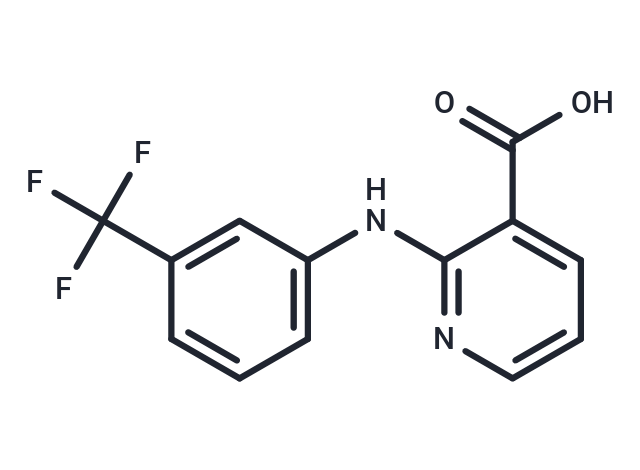Shopping Cart
Remove All Your shopping cart is currently empty
Your shopping cart is currently empty
Niflumic acid (Nifluril) is a Ca2+-activated Cl- channel blocker and an analgesic and anti-inflammatory agent used in the therapy of rheumatoid arthritis.

| Pack Size | Price | USA Warehouse | Global Warehouse | Quantity |
|---|---|---|---|---|
| 50 mg | $44 | In Stock | In Stock | |
| 100 mg | $54 | In Stock | In Stock | |
| 200 mg | $75 | In Stock | In Stock | |
| 500 mg | $119 | In Stock | In Stock | |
| 1 mL x 10 mM (in DMSO) | $50 | In Stock | In Stock |
| Description | Niflumic acid (Nifluril) is a Ca2+-activated Cl- channel blocker and an analgesic and anti-inflammatory agent used in the therapy of rheumatoid arthritis. |
| Targets&IC50 | COX-2:100 nM |
| In vivo | Niflumic acid suppresses calcium-activated currents on the basolateral membrane of rat pancreatic exocrine cells with an IC50 of 50 μM. It dose-dependently and reversibly activates the calcium-activated potassium (KCa) channels. Niflumic acid induces a spontaneous transient concentration-dependent inhibition of inward currents (STIC, calcium-activated chloride currents) amplitude. It inhibits calcium-activated chloride channels with a Ki of 17 mM. Additionally, Niflumic acid suppresses ICl(Ca) under the permeabilizing effect of Ca2+ on oocytes through Ca2+ ionophore A23187, suggesting the inhibition of ICl(Ca) results from direct interaction with Cl- channels, not by disruption of Ca2+ entry through voltage-dependent Ca2+ channels. Niflumic acid attenuates norepinephrine and caffeine-induced inward currents (IO(Ca)) with an IC50 of 6.6 μM, which is less effective than that on spontaneous currents. It exhibits a voltage-dependent inhibition of the amplitude of spontaneous transient currents (STIC), with IC50 values of 1.1 μM at +50 mV and 2.3 μM at -50 mV. Furthermore, Niflumic acid reduces airway hyperresponsiveness and eosinophilic infiltration, as well as inhibits IL-13 induced goblet cell hyperplasia. Following the IL-13 challenge, Niflumic acid hampers the overexpression of the MUC5AC gene (a marker of goblet cell proliferation) and levels of chemokines in bronchoalveolar lavage fluid. It also represses the activation of JAK/STAT6, AK2, and the expression of chemokines in epithelial cells. |
| Synonyms | Nifluril, Landruma, Forenol |
| Molecular Weight | 282.22 |
| Formula | C13H9F3N2O2 |
| Cas No. | 4394-00-7 |
| Smiles | OC(=O)C1=CC=CN=C1NC1=CC=CC(=C1)C(F)(F)F |
| Relative Density. | 1.3935 g/cm3 (Estimated) |
| Storage | Powder: -20°C for 3 years | In solvent: -80°C for 1 year | Shipping with blue ice/Shipping at ambient temperature. | |||||||||||||||||||||||||||||||||||
| Solubility Information | DMSO: 60 mg/mL (212.6 mM), Sonication is recommended. H2O: < 1 mg/mL (insoluble or slightly soluble) Ethanol: < 1 mg/mL (insoluble or slightly soluble) | |||||||||||||||||||||||||||||||||||
| In Vivo Formulation | 10% DMSO+40% PEG300+5% Tween 80+45% Saline: 2 mg/mL (7.09 mM), Sonication is recommended. Please add the solvents sequentially, clarifying the solution as much as possible before adding the next one. Dissolve by heating and/or sonication if necessary. Working solution is recommended to be prepared and used immediately. The formulation provided above is for reference purposes only. In vivo formulations may vary and should be modified based on specific experimental conditions. | |||||||||||||||||||||||||||||||||||
Solution Preparation Table | ||||||||||||||||||||||||||||||||||||
DMSO
| ||||||||||||||||||||||||||||||||||||
| Size | Quantity | Unit Price | Amount | Operation |
|---|

Copyright © 2015-2025 TargetMol Chemicals Inc. All Rights Reserved.